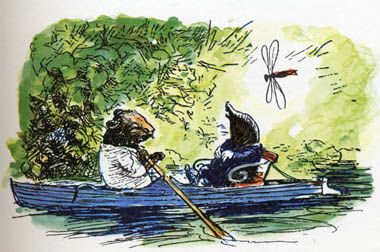The Wind in the Willows
Kenneth Grahame
Scotland, 1908
The Water Rat was restless, and he did not exactly know why. To all appearance the summer’s pomp was still at fullest height, and although in the tilled acres green had given way to gold, though rowans were reddening, and the woods were dashed here and there with a tawny fierceness, yet light and warmth and color were still present in undiminished measure, clean of any chilly premonitions of the passing year. But the constant chorus of the orchards and hedges had shrunk to a casual evensong from a few yet unwearied performers; the robin was beginning to assert himself once more; and there was a feeling in the air of change and departure.
Chapter 9

Back in the spring, prompted by a post from Cleo at Classical Carousel, I decided that August would be a perfect time for a read of The Wind in the Willows. And indeed it was: the slow rhythm of passing seasons, of life on the riverbank, is a perfect companion to what I think of as the lazy days of late summer.
But The Wind in the Willows is perfect at many times of year. Nestled cozily protected from winter’s snow, lingering in warm spring breezes, relaxing in summer’s heat, enjoying the crisp cool of autumn–all are equally at home with the residents of the idyllic riverbank.
Much like Cranford, The Wind in the Willows is an episodic tale with early standalone chapters that eventually give way to a final set of connected chapters, all set to the rhythms of the changing seasons. Save for Toad’s frequent misadventures following the latest craze, there is no hurry, no anxiety for the next thing. The animals of the story–Rat and Mole and Badger and Otter–are in communion with the world around them, living and moving by its paces. They understand the changes of the seasons, acknowledge them, adapt to them, live by their rhythms. As I read, it occurred to me that these characters knew something most of us have lost. It is part of the appeal of these tales.
But of course the personalities of the animal friends are also greatly attractive. The irrepressible Toad, the steadfast Mole, the open-hearted Rat, the benevolent Badger. Although Toad’s antics may be the most memorable, his friends’ loyal determination to set him right, to help him overcome his own faults, is lovely indeed. They seem perhaps to be types, characters I might see in a Victorian or Edwardian novel, but their animal natures provide that additional charm and distinction. Add to this the depiction of loyal friendship and they are a wonderful set of creatures to pass time with.
The setting is not merely pastoral, but Edwardian, and there is a real sense of the time and of its space between an idealized agrarian past and the onrush of an industrial–motorized–future. Grahame seems to favor the historic ideal, but there is also a timeless critique of the failings of character. It is not merely that Toad seeks out the latest fad or the rush of speed, he is also at fault for letting his passions overtake his reason, to the extent that he could loose everything he has, perhaps even his friends.
There seems perhaps a rush at the end–everything hastens to tie up neatly, and the conclusion feels abrupt. It is no wonder that so many sequels from other authors have appeared. But perhaps I don’t mind this after all. For now the animals may still live on the riverbank, I may still have my doubts about Toad, and when the seasons change, I can be sure that they will be adapting with them.
I read The Wind in the Willows as part of my Children’s Classics project list and for Back to the Classics, Classic with Nature in the Title.
Great review! I never thought of it that way…about how all of the seasons are captured throughout the telling of the story. This is so true. I’m not sure if it is the representation of nature or Grahame’s descriptive writing that makes the feeling of the seasons come alive. But it really works.
Thanks, Ruth! I think I’ve been much more aware of the seasons this year as I’ve spent a lot more time out of doors walking, so it was something that caught my eye. Certainly something very appealing to me.
I wanted to read it (again) this summer, but didn’t manage it. Spring seems like a good time, though…
Jean, I agree, spring would be good! It starts with Mole spring-cleaning, after all.
Lovely review of an old favourite. Life always seems better when you spend some time with Ratty and Mole. 😀
Thank you, Fiction Fan!
I agree–these are lovely characters to spend time with. I’ve been thinking of revisiting the Christmas chapter in honor of the season.
Just reading your review makes me want to read it again. I never thought of comparing it to Cranford but you’re so right! And I completely agree with Fiction Fan …. life is so much better with Ratty and Mole!
Cleo, I think I read Cranford and The Wind in the Willows so close together it was a natural comparison. I wonder how many other books out there have that same format that I just haven’t read?
I can’t believe I haven’t read this, I must get on with it. The Edwardian setting with a look in both directions is such a good description.
Jane, do read it! It’s a lovely book.